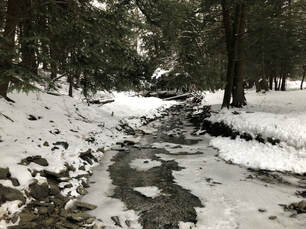CONSERVATION CORNER
A weekly blog for all things conservation
 By: Bryan Swistock, Senior Extension Associate: Water Resource Associate, Penn State Extension Although last winter was one of the least snowy on record for much of Pennsylvania, recent snowstorms in parts of the state have brightened the mood of snow enthusiasts who enjoy skiing, snowmobiling, snowshoeing, hunting, and ice fishing. But forests blanketed in snow should also be appreciated by those who enjoy streams in the summer and rely on groundwater wells and springs for drinking water supplies. That’s because forests and snowpack together allow for recharge of underground aquifers that consist of 80 trillion gallons of freshwater stored in the pore spaces and cracks in rock beneath the surface. These aquifers serve to maintain the flow of streams throughout the year and provide water that supports industries, businesses, agriculture, and drinking water for millions of Pennsylvania residents. In an average year, 10% to 25% of the water that flows in streams and enters groundwater wells originates from melting snow. The forest creates a perfect environment to capture and slowly melt snow into the ground. The soil under forest canopies acts like a sponge to soak up and pass water from the surface into groundwater aquifers. Where forests are removed, the soil may become compacted or even paved, reducing the amount of water that can infiltrate into the ground to support aquifers. Infiltration of water into the ground occurs most efficiently during times when the forest is dormant. That’s where a thick snowpack becomes beneficial.
The snowpack that accumulates during the winter insulates the soil underneath it, keeping the soil largely unfrozen and able to absorb water from melting snow. Since trees and other plants are dormant during early spring, most of the snowmelt water entering the soil can infiltrate and recharge groundwater aquifers. The snowpack also represents a large volume of stored water that can be released slowly during the spring melt. A ten-inch snowpack covering just one acre may hold 30,000 gallons of water or more. Once the snow is gone and trees leaf-out in late spring, most infiltrating water from summer rainstorms is taken up by the roots of the growing trees. This cycle results in high groundwater levels during March and April that typically fall throughout the summer and early fall. Ground water aquifers that are recharged in the spring by melting snow provide water supply wells and streams with a steady source of cool ground water during the long, hot summer. Fish and other stream life have adapted to the increased stream flows in spring and the relatively cool ground water that is supplied to the stream throughout the summer. Without this spring recharge, stream levels may drop, and stream temperatures may increase to dangerous levels during the summer. So the next time you cast a fly over a rising trout or take a drink of water from your well or spring, remember that the combination of undisturbed forests and winter snowpack provides much of the groundwater that we rely on every day. Thank you to Penn State Extension for permission to reprint this article. The original article can be found at this link: https://extension.psu.edu/the-importance-of-snow-and-forests-to-pennsylvania-streams-and-groundwater The Bradford County Conservation District is committed to helping people manage resources wisely. You can visit the Bradford County Conservation District at 200 Lake Rd in Wysox across from the Wysox Fire Hall. Contact us at (570) 485-3144 or visit our web page at www.bccdpa.com.
2 Comments
9/6/2022 09:19:44 pm
I had no idea that melting snow accounts for 10% to 25% of the water that flows in streams and enters groundwater wells on an annual basis. Interesting! Thank you for providing this information. Blog is well-written and informative.
Reply
5/29/2023 09:10:29 pm
Snow may be captured and gradually melted into the earth in the woodland.Water from the surface is absorbed and transported into groundwater aquifers by the soil beneath forest canopies in a manner similar to a sponge.The quantity of water that can permeate the earth to support aquifers may be decreased if woods are cleared because the soil may become compacted or even paved.The best periods for infiltration of water into the earth are when the forest is dormant. A substantial snowfall is helpful in this situation.
Reply
Leave a Reply. |
AuthorsVarious staff at the Bradford County Conservation District Archives
April 2024
Categories
All
|
